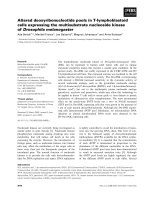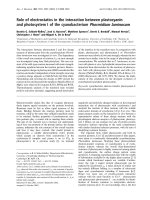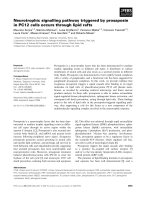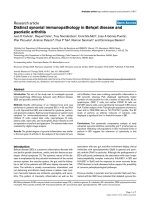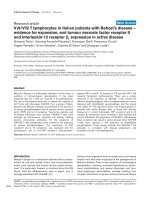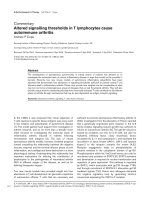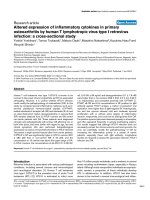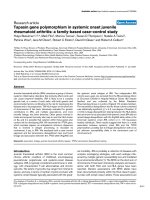Báo cáo y học: "Altered signalling thresholds in T lymphocytes cause autoimmune arthritis." ppsx
Bạn đang xem bản rút gọn của tài liệu. Xem và tải ngay bản đầy đủ của tài liệu tại đây (68.03 KB, 5 trang )
112
IL = interleukin; JAK = Janus kinase; RA = rheumatoid arthritis; SHP = src homology 2 domain-bearing protein tyrosine phosphatase; SOCS = sup-
pressor of cytokine signalling; STAT = signal transducer and activator of transcription; TCR = T-cell receptor.
Arthritis Research & Therapy Vol 6 No 3 Cope
In the 1980s it was proposed that clonal expansion of
T cells reactive to specific tissue antigens was a key event
in the initiation and perpetuation of autoimmune disease
[1]. This model gained much support from investigators in
arthritis research, and so for more than a decade much
effort focused on investigating the molecular basis of
inflammatory arthritis induced in rodents following
immunization with antigens [2]. The lack of robust
spontaneous arthritis models, however, hindered progress
toward unravelling the relationship between the adaptive
immune response and the terminal effector phase of joint
inflammation, and cartilage and bone destruction in a more
physiological setting. Understanding this relationship has
important implications for defining the contribution of
lymphocytes to the pathogenesis of rheumatoid arthritis
(RA) at different stages of the disease, as well as for
defining therapeutic targets.
Two new mouse models have provided insight into how
aberrations in T-cell development can generate a repertoire
of autoreactive effector T cells that are necessary and
sufficient to promote spontaneous inflammatory arthritis. In
2002, investigators from the laboratory of Hirano reported
that a genetically engineered point mutation in the IL-6
family receptor signalling subunit gp130 was sufficient to
induce an autoimmune arthritis [3]. The gp130 subunit is
shared by receptors not only for IL-6 itself, but also for
leukaemia inhibitory factor, ciliary neurotropic factor,
oncostatin M, IL-11 and cardiotropin-1, and facilitates the
recruitment of Janus kinase (JAK)-1, JAK-2 and tyrosine
kinase-2 to the receptor complex (for review [4,5]).
Receptor engagement leads to phosphorylation of
tyrosine residues in the cytoplasmic domain of gp130.
Phosphotyrosine within the YxxQ motif serves as a site for
recruitment and activation of STAT3 [6]. STAT3 activation
and dimerization is required for nuclear translocation and
regulation of gene expression. This pathway is regulated
by SHP-2, which associates with gp130 through Y759,
and through recruitment of SOCS-3 it attenuates gp130
mediated signals [7,8]. Hirano and colleagues disrupted
this negative regulatory loop by generating knock-in
mouse lines expressing the 759Y to F mutation.
Commentary
Altered signalling thresholds in T lymphocytes cause
autoimmune arthritis
Andrew P Cope
Kennedy Institute of Rheumatology Division, Faculty of Medicine, Imperial College, London, UK
Corresponding author: Andrew P Cope (e-mail: )
Received: 25 Feb 2004 Revisions requested: 2 Apr 2004 Revisions received: 5 Apr 2004 Accepted: 7 Apr 2004 Published: 23 Apr 2004
Arthritis Res Ther 2004, 6:112-116 (DOI 10.1186/ar1185)
© 2004 BioMed Central Ltd
Abstract
The development of spontaneous autoimmunity in inbred strains of rodents has allowed us to
investigate the molecular basis of chronic inflammatory disease in ways that would not be possible in
humans. Recently, two new mouse models of autoimmune inflammatory polyarthritis have been
reported that demonstrate how alterations in signalling thresholds sufficient to perturb central T-cell
tolerance lead to inflammatory arthritis. These mice provide new insights into the complexities of what
may turn out to be a heterogeneous group of diseases that we call rheumatoid arthritis. They will also
provide unique tools for dissecting precisely how chronically activated T cells contribute to the effector
phase of arthritis through mechanisms that may be less dependent on antigen receptor signalling.
Keywords: autoimmune arthritis, signalling, T cells, thymic selection
113
Available online />Although gp130
F759/F759
mice are normal at birth, they
develop splenomegaly and lymphadenopathy associated
with increased generation of T-helper-1 cells and hyper-
gammaglobulinaemia. By 8 months of age gp130
F759/F759
mice develop a symmetrical and peripheral inflammatory
arthropathy, progressing from toes and wrists to larger
joints by 16 months. Disease occurred earlier and with
greater severity in females. Histological analysis revealed a
proliferative synovitis comprised predominantly of neutro-
phils, with few lymphocytes or plasma cells, associated
with severe bony destruction, ankylosis in many joints, and
reactive sclerotic changes. IgG rheumatoid factor, anti-
single and anti-double stranded DNA antibodies, and
antibodies to ribonucleoproteins were detected in serum.
More detailed investigation of lymphocyte development
uncovered a reduced frequency of CD4
+
CD8
+
double
positive thymocytes in the mutant mice, associated with
increased CD4
+
or CD8
+
single positive thymocytes as
compared with wild-type littermates. In peripheral lymph
nodes CD62L
–
CD44
+
activated memory T cells
predominated, with increased expression of activation
surface antigens CD69 and CD25, and hyperresponsive-
ness to T cell receptor (TCR) ligation with anti-CD3 anti-
bodies.
The finding of increased numbers of activated T cells in
otherwise naïve gp130
F759/F759
mice suggested that
mechanisms of tolerance might be perturbed. Central
tolerance was assessed by examining thymic selection of
gp130
F759/F759
mutant male antigen-specific T cells using
the H-Y TCR transgenic mouse model [9]. The frequency
of CD8
+
H-Y specific thymocytes in female mutant mice
was comparable to that observed in wild-type mice,
indicating that positive selection was not affected by the
gp130 mutation. In contrast, impaired negative selection
of CD8
+
T cells was suggested by increased numbers of
CD8
lo
thymocytes, indicative of mutant H-Y specific cells
that have escaped negative selection, as well as by
increased double positive thymocytes. Defects in clonal
deletion were also suggested by the observation of
impaired reduction in Vβ8 T cell numbers after injection of
superantigen. Biochemical analysis of IL-6 signals in
gp130
F759/F759
mutant T cells confirmed sustained and
prolonged tyrosine phosphorylation of JAK-1 and STAT-3
and the absence of IL-6 induced SOCS-3 induction.
Prolonged STAT3 activation was associated with IL-6
induced inhibition of activation induced cell death and
failure to upregulate Fas ligand upon anti-CD3 stimulation.
The fact that arthritis did not develop in RAG-2 deficient
gp130
F759/F759
mice suggested that aberrations in
lymphocyte gp130 signalling in this model were
particularly important for the development of arthritis. We
learn from these mice that a single amino acid substitution,
capable of promoting gp130 signalling, is sufficient to
perturb central tolerance, leading to increased numbers of
self-reactive T cells in the periphery.
In the 27 November 2003 issue of the journal Nature,
Sakaguchi and colleagues [10] reported spontaneous
arthritis developing in their inbred Balb/c colony (named
SKG mice hereafter). The disease had many features of
human RA, including a peripheral symmetrical arthritis
leading to pannus eroding cartilage and subchondral
bone, and joint destruction that was more severe in
females. Although the synovitis was typical of RA with a
predominant lymphocytic infiltrate, a systemic inflam-
matory disease was also evident in older mice characterized
by pneumonitis, dermal infiltration, subcutaneous nodules
and vasculitis – features not dissimilar to recognized extra-
articular manifestations of RA. In keeping with this
phenotype was a serotype characterized by high titres of
IgG rheumatoid factor, autoantibodies to collagen II and
hsp70, hypergammaglobulinaemia and increased circulat-
ing immune complexes, but no anti-DNA antibodies. The
chronic inflammatory arthritis was T-cell dependent, as
demonstrated in adoptive transfer experiments of splenic,
lymph node or thymic CD4
+
T cells into Balb/c nude or
severe combined immunodeficiency mice. By contrast,
transfer of sera from arthritic mice was not arthritogenic.
Analysis of offspring from a series of SKG crosses
implicated a genetic anomaly of a single gene locus
inherited in an autosomal recessive fashion, with near
100% penetrance of homozygotes. Linkage analysis using
microsatellite markers mapped the skg locus to the
centromeric portion of chromosome 1. A single G/T
transposition within the ZAP-70 coding sequence was
subsequently found to segregate with skg disease. The
mutation encodes a switch at codon 163 from tryptophan
to cystein (W163C), corresponding to the initial amino
acid residue of the carboxyl-terminal SH2 domain of
ZAP-70. Transgenic expression of the ZAP-70
skg
allele on
a ZAP-70 deficient background confirmed that the ZAP-
70 mutation was necessary and sufficient for the
development of arthritis.
Biochemical analysis demonstrated that the ZAP-70
W163C
mutation attenuated membrane proximal TCR signalling,
leading to profound proliferative hyporesponsiveness of T
cells to TCR engagement in spite of expressing an
activated CD44
hi
, CD45RB
lo
, LFA-1
hi
, ICAM-1
hi
phenotype. This biochemical TCR signalling deficit
translated to functional aberrations of thymic development
manifest by reduced thymocyte apoptosis in vivo following
anti-CD3 injection, increased numbers of TCR
lo
thymocytes, and reduced numbers of peripheral CD4
+
or
CD8
+
T cells. Impaired positive selection was observed in
skg/skg DO11.10 TCR transgenic mice, as well as in
skg/skg female H-Y TCR transgenic mice, whereas
impaired negative selection of H-Y specific CD8
+
T cells
was demonstrated in male H-Y TCR transgenic skg/skg
mice, when compared with H-Y TCR transgenic litter-
mates. Arthritis developed in the majority of either H-Y or
114
Arthritis Research & Therapy Vol 6 No 3 Cope
DO11.10 TCR transgenic mice that were also
homozygous for the ZAP-70
W163C
mutation, implying that
this mutation leads to the selection of arthritogenic T cells
expressing transgenic TCRβ chains pairing with
endogenous TCRα chains. These data pointed to a shift in
thymic selection of the peripheral T-cell repertoire as the
primary cause of autoimmune arthritis as a direct
consequence of a point mutation in a tyrosine kinase
pivotal for transmitting signals from the TCR to
downstream pathways.
Both the SKG and gp130
F759/F759
mice develop
spontaneous autoimmune arthritis because the signals
that normally promote deletion of autoreactive T cells in
the thymus are defective, but there the similarity ends.
One striking immunological phenotype that distinguishes
these models is the responsiveness to TCR stimulation;
T cells from gp130
F759/F759
mice are hyperresponsive,
whereas SKG T cells are profoundly hyporesponsive. So
how can extremes of T-cell reactivity both promote
inflammatory arthritis? The development of arthritis in
gp130
F759/F759
mice is perhaps easiest to digest. First,
there is unbridled gp130-mediated signalling and chronic
STAT3 activation in all cells because SHP-2 mediated
regulation is impaired [8,11]. Peripheral T cells express a
memory/activated phenotype, differentiate toward
T-helper-1 cells, and are refractory to peripheral clonal
deletion. Persistence of activated clones in vivo would
certainly account for hypergammaglobulinaemia and the
extensive panel of autoantibodies detected in the sera of
gp130
F759/F759
mice. On the other hand, Hirano and
colleagues [11] previously showed that stimulation of
gp130
F759/F759
mutant B cells with anti-CD40 alone
enhances immunoglobulin production, which is further
augmented with IL-6, whereas B-cell proliferative
responses are no different from those of B cells from wild-
type mice. This suggests that other cell types must be
contributing to the pathological process. For example, it is
equally plausible that aberrant gp130 signalling in
endothelial cells, macrophages, or fibroblast-like synovio-
cytes contribute to the inflammatory synovitis through
mechanisms independent of T cells. Generation of tissue
specific gp130
F759/F759
mutant mouse lines would
address this directly.
The SKG mouse is also intriguing but for different
reasons. Here the mutation is highly specific not only for
CD4
+
and CD8
+
T cells but also for targeting the TCR
signalling pathway. ZAP-70 is the most membrane
proximal protein tyrosine kinase. It is recruited to the
TCR–CD3 complex upon ligation-induced phosphory-
lation of YxxL immunoreceptor tyrosine activation motifs in
the cytoplasmic tails of TCRζ and CD3ε, γ and δ chains
[12]. By binding to tandemly arranged immunoreceptor
tyrosine activation motifs, ZAP-70 SH2 domains couple
the receptor complex to downstream Ras/ERK and
calcium signalling pathways [13]. Thus, the effects on
negative thymic selection and the development of a
repertoire of highly self-reactive T cells could be
predicted. Indeed, Sakaguchi and colleagues [10]
documented that physical association between mutant
ZAP-70 and TCRζ is reduced. What is harder to reconcile
is how impaired TCR signalling and proliferative
responses can translate into an arthritogenic T-cell
effector response that induces chronic inflammation in a
disease model of RA in which MHC associations and
lymphocytic synovial infiltrates support the concept of
chronic antigen stimulation. On the other hand, more
recent data demonstrate that T cells in rheumatoid
synovium are paradoxically hyporesponsive to TCR
ligation, leading to attenuation of proliferative and cytokine
responses (for review [14]).
A number of possible explanations spring to mind.
Perhaps the simplest is that TCR signals in peripheral skg
T cells are sufficient for activation and terminal
differentiation of effector T cells. Indeed, T-helper-1 and T-
helper-2 cells are known to have distinct signalling
thresholds for activation, at least in mouse models of T-cell
differentiation [15,16]. Sakaguchi and coworkers [10]
speculate that resident synovial cells, as distinct from
stromal cells derived from other tissues, are especially
sensitive to signals generated by chronically activated T
cells, including cytokines. Interestingly, in tumour necrosis
factor or IL-1 gene deficient SKG mice the incidence of
arthritis is reduced to 20%, whereas arthritis is not
observed at all on an IL-6 deficient background
(Sakaguchi S, personal communication). Although ZAP-
70 is not expressed in fibroblast-like synoviocytes, it is
conceivable that the effector function of mutant T cells
promotes fibroblast proliferation, as well as the secretion
of cytokines and other effector molecules such as matrix
metalloproteinases, through cell contact dependent
mechanisms in situ, which are less dependent on T-cell
antigen receptor signals.
More controversial would be the idea that effector
responses of terminally differentiated ZAP-70 mutant
T cells are independent of antigen signals. According to
this model, skg T cells would stimulate synoviocytes to
proliferate and activate B cells to produce antibody,
perhaps through cell contact dependent mechanisms or
by secretion of T-cell products on engagement of
receptors other than the TCR [17,18]. Data suggest that
subsets of RA synovial T cells, as well as having proximal
TCR signalling defects [14], may well behave in this way,
being sustained in vivo by chronic cytokine rather than
antigen stimulation [19]. Another possibility, and one that
must appeal to Sakaguchi, would be that ZAP-70
W163C
impairs the generation and/or function of CD4
+
CD25
+
regulatory T cells. A progressive imbalance of effector and
regulatory cell numbers could account for the systemic
115
Available online />inflammation and autoimmunity in SKG mice, not dissimilar
from that in mice following depletion of CD5
high
or
CD25
high
CD4
+
T cell subsets in vivo, which was reported
by Sakaguchi and colleagues some years ago [20,21].
The finding that depletion of CD4
+
CD25
+
T cells
exacerbates arthritis is consistent (Sakaguchi S, personal
communication). Finally, the possibility that the ZAP-
70
W163C
mutation alters the repertoire of peripheral
CD4
+
CD25
+
T regulatory cells needs exploring.
Whatever the mechanism, this mouse will provide an
invaluable tool with which to dissect the progression
through key checkpoints during the evolution of arthritis.
These checkpoints of T-cell activation, clonal expansion
and differentiation are illustrated in Fig. 1. In particular, the
model should be applied to address the critical question
of why alterations in T-cell repertoire lead specifically to
arthritis but not to other autoimmune diseases. Thus far the
autoantibody profile seems remarkably similar to that seen
in human RA, and so it will be of considerable interest to
know whether reactivity to specific antigens and clonal
expansion of skg T cells is of importance in this model.
In their report, Hirano and colleagues [3] reflect upon the
diverse array of engineered mutant strains that induce
spontaneous inflammatory arthritis and consider whether
this might reflect either the heterogeneity of the human
disease we recognize as RA, or the great complexity that
underlies the disease process. On the face of it, both
ZAP-70
W163C
and gp130
F759/F759
mutations induce auto-
immune arthritis because of a breakdown in central and
peripheral T-cell tolerance. Similar defects in tolerance
have been described in the K/B × N TCR transgenic
arthritis model of Benoist and Mathis [22], even though
passive transfer of skg serum does not elicit arthritis.
However, the biochemistry, the cellular phenotypes, the
serology and the histopathology are all quite distinct in
these models; indeed, the clinical features are also
different. Notwithstanding the strain differences, analysis
of these mouse models suggests that there exists both
great heterogeneity of disease and complexity at the
molecular level. We now face the daunting challenge of
reclassifying, at a molecular level, the inflammatory arthritis
of our patients in the clinic. This is important not just to
satisfy our intellectual curiosity. Indeed, if the molecular
basis of inflammatory arthritis differs for subsets of RA
patients, then it follows that therapy should be selected to
match the disease. The observed responder rates of RA
patients to different biological therapies seem consistent
with this notion.
Figure 1
Checkpoints in T-cell development, differentiation and effector function in the pathogenesis of chronic inflammatory arthritis. A repertoire of
arthritogenic T cells is shaped during thymic selection on MHC molecules complexed to self-antigenic peptides. Signalling thresholds will dictate
which cells undergo positive and negative selection, as well as those cells that become activated and undergo clonal expansion in the periphery
(‘antigen mode’). Persistence of chronically activated T cells in vivo, augmented by failure to undergo activation-induced cell death (or propriocidal
regulation), will promote effector function through cytokine overexpression and cell contact dependent mechanisms, leading to activation of
monocytes, fibroblasts and B cells in situ (‘inflammation mode’). This terminal phase is manifested by chronic cytokine expression, invasion of
cartilage and subchondral bone by pannus, and autoantibody production. Proposed pathways of activation and differentiation perturbed by
ZAP-70
W163C
or gp130
F759/F759
mutations are indicated.
thymus
peripheral
T cell
repertoire
protective
immu
nity
T CELL
ACTIVATION
CLONAL
EXPANSION
EFFECTOR
RESPONSE
NON-SUSCEPTIBLE
HOST
SUSCEPTIBLE
HOS
T
RESOLUTION
(default pathway)
protective
immu
nity
CHRONIC
INFLAMMATION
CHECKPOINT #1 CHECKPOINT #2 CHECKPOINT #3
antigen
driv
e
failure of
immunoregulation
immunoregulation
autoAb, tissue destruction
“shaped” by MHC
ZA
W163C
gp130
F759/F759
ZAP-70
W163C
ZAP-70
W163C
gp130
F759/F759
ZAP-70
W163C
gp130
F759/F759
ZAP-70
W163C
gp130
F759/F759
gp130
F759
INFLAMMATION MODEANTIGEN MODE
cytokine drive
P-70
F759/
116
Competing interests
None declared.
Acknowledgements
APC is a Wellcome Trust Senior Fellow in Clinical Science. The author
especially wishes to thank Dr Shimon Sakaguchi for generously com-
municating unpublished data.
References
1. Janossy G, Panayi G, Duke O, Bofill M, Poulter LW, Goldstein G:
Rheumatoid arthritis: a disease of T-lymphocyte/macrophage
immunoregulation. Lancet 1981, 2:839-842.
2. Holmdahl R, Andersson M, Goldschmidt TJ, Gustafsson K, Jansson
L, Mo JA: Type II collagen autoimmunity in animals and provo-
cations leading to arthritis. Immunol Rev 1990, 118:193-232.
3. Atsumi T, Ishihara K, Kamimura D, Ikushima H, Ohtani T, Hirota S,
Kobayashi H, Park SJ, Saeki Y, Kitamura Y, Hirano T: A point
mutation of Tyr-759 in interleukin 6 family cytokine receptor
subunit gp130 causes autoimmune arthritis. J Exp Med 2002,
196:979-990.
4. Hirano T, Nakajima K, Hibi M: Signaling mechanisms through
gp130: a model of the cytokine system. Cytokine Growth
Factor Rev 1997, 8:241-252.
5. Taga T, Kishimoto T: Gp130 and the interleukin-6 family of
cytokines. Annu Rev Immunol 1997, 15:797-819.
6. Hirano T, Ishihara K, Hibi M: Roles of STAT3 in mediating the
cell growth, differentiation and survival signals relayed
through the IL-6 family of cytokine receptors. Oncogene 2000,
19:2548-2556.
7. Nicholson SE, De Souza D, Fabri LJ, Corbin J, Willson TA, Zhang
JG, Silva A, Asimakis M, Farley A, Nash AD, Metcalf D, Hilton DJ,
Nicola NA, Baca M: Suppressor of cytokine signaling-3 prefer-
entially binds to the SHP-2-binding site on the shared
cytokine receptor subunit gp130. Proc Natl Acad Sci USA
2000, 97:6493-6498.
8. Lehmann U, Schmitz J, Weissenbach M, Sobota RM, Hortner M,
Friederichs K, Behrmann I, Tsiaris W, Sasaki A, Schneider-Mer-
gener J, Yoshimura A, Neel BG, Heinrich PC, Schaper F: SHP2
and SOCS3 contribute to Tyr-759-dependent attenuation of
interleukin-6 signaling through gp130. J Biol Chem 2003, 278:
661-671.
9. Kisielow P, Teh HS, Bluthmann H, von Boehmer H: Positive
selection of antigen-specific T cells in thymus by restricting
MHC molecules. Nature 1988, 335:730-733.
10. Sakaguchi N, Takahashi T, Hata H, Nomura T, Tagami T, Yamazaki
S, Sakihama T, Matsutani T, Negishi I, Nakatsuru S, Sakaguchi S:
Altered thymic T-cell selection due to a mutation of the ZAP-
70 gene causes autoimmune arthritis in mice. Nature 2003,
426:454-460.
11. Ohtani T, Ishihara K, Atsumi T, Nishida K, Kaneko Y, Miyata T, Itoh
S, Narimatsu M, Maeda H, Fukada T, Itoh M, Okano H, Hibi M,
Hirano T: Dissection of signaling cascades through gp130 in
vivo: reciprocal roles for STAT3- and SHP2-mediated signals
in immune responses. Immunity 2000, 12:95-105.
12. Chan AC, Iwashima M, Turck CW, Weiss A: ZAP-70: a 70 kd
protein-tyrosine kinase that associates with the TCR zeta
chain. Cell 1992, 71:649-662.
13. Weiss A, Littman DR: Signal transduction by lymphocyte
antigen receptors. Cell 1994, 76:263-274.
14. Cope AP: Studies of T-cell activation in chronic inflammation.
Arthritis Res 2002, Suppl 3:S197-S211.
15. Hosken NA, Shibuya K, Heath AW, Murphy KM, O’Garra A: The
effect of antigen dose on CD4
+
T helper cell phenotype devel-
opment in a T cell receptor-alpha beta-transgenic model. J
Exp Med 1995, 182:1579-1584.
16. Tao X, Constant S, Jorritsma P, Bottomly K: Strength of TCR
signal determines the costimulatory requirements for Th1 and
Th2 CD4
+
T cell differentiation. J Immunol 1997, 159:5956-
5963.
17. Yamamura Y, Gupta R, Morita Y, He X, Pai R, Endres J, Freiberg
A, Chung K, Fox DA: Effector function of resting T cells: activa-
tion of synovial fibroblasts. J Immunol 2001, 166:2270-2275.
18. Burger D, Dayer JM: The role of human T-lymphocyte-mono-
cyte contact in inflammation and tissue destruction. Arthritis
Res 2002, Suppl 3:S169-S176.
19. Brennan FM, Hayes AL, Ciesielski CJ, Green P, Foxwell BM, Feld-
mann M: Evidence that rheumatoid arthritis synovial T cells
are similar to cytokine-activated T cells: involvement of phos-
phatidylinositol 3-kinase and nuclear factor kappaB pathways
in tumor necrosis factor alpha production in rheumatoid
arthritis. Arthritis Rheum 2002, 46:31-41.
20. Sakaguchi S, Fukuma K, Kuribayashi K, Masuda T: Organ-spe-
cific autoimmune diseases induced in mice by elimination of
T cell subset. I. Evidence for the active participation of T cells
in natural self-tolerance; deficit of a T cell subset as a possi-
ble cause of autoimmune disease. J Exp Med 1985, 161:72-
87.
21. Sakaguchi S, Sakaguchi N, Asano M, Itoh M, Toda M: Immuno-
logic self-tolerance maintained by activated T cells express-
ing IL-2 receptor alpha-chains (CD25). Breakdown of a single
mechanism of self-tolerance causes various autoimmune dis-
eases. J Immunol 1995, 155:1151-1164.
22. Kouskoff V, Korganow AS, Duchatelle V, Degott C, Benoist C,
Mathis D: Organ-specific disease provoked by systemic
autoimmunity. Cell 1996, 87:811-822.
Arthritis Research & Therapy Vol 6 No 3 Cope

